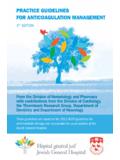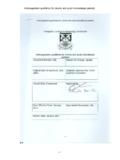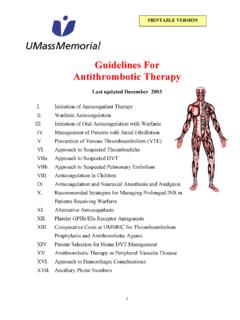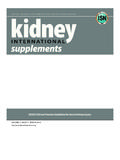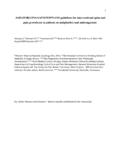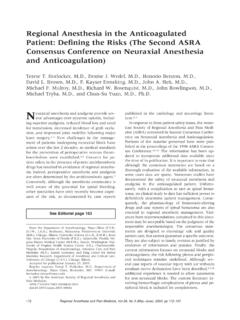Transcription of KDIGO Clinical Guidelines for Management of AKI
1 KDIGO Clinical Guidelines for Management of AKI. Noel Gibney MB FRCP(C). Professor, Division of Critical Care Medicine University of Alberta Disclosure Gambro: Expert Panel Fellowship Funding Kidney Disease: Improving Global Outcomes Kidney Int 2012;2(Suppl):1-138. Kidney Disease: Improving Global Outcomes KDIGO . An independently incorporated nonprofit foundation, governed by an international board, with the stated mission to: Improve the care and outcomes of kidney disease patients worldwide through promoting coordination, collaboration, and integration of initiatives to develop and implement Clinical practice Guidelines .'. Kidney Disease: Improving Global Outcomes Guiding Principles for KDIGO Guideline Development Scientific and methodological rigor Interdisciplinary approach Independence of work groups Transparency of the guideline development process Kidney Disease: Improving Global Outcomes Published Clinical Practice Guidelines Prevention, Diagnosis, Evaluation, and Treatment of Hepatitis C in CKD.
2 Published in Kidney International in April, 2008. Diagnosis, Evaluation, Prevention, and Treatment of CKD-MBD. Published in Kidney International in July, 2009. Care of Kidney Transplant Recipients Published in the American Journal of Transplantation in October, 2009; Executive Summary published in Kidney International in December, 2009. Kidney Disease: Improving Global Outcomes Why KDIGO Guidelines on AKI Management ? AKI is common. AKI imposes a heavy burden of illness (morbidity and mortality). The cost per person of managing AKI is high. AKI is amenable to early detection and potential prevention. There is considerable variability in practice to prevent, diagnose, treat, and achieve outcomes of AKI. Clinical practice Guidelines in the field have the potential to reduce variations, improve outcomes, and reduce costs. Formal Guidelines do not exist on this topic. Kidney Disease: Improving Global Outcomes Grade Patients Clinicians Policy Level 1 Most patients in Most patients should The We recommend your situation receive the recommendation would want the recommended course can be evaluated recommended of action.
3 As a candidate for course of action developing a policy and only a few or performance would not. measure. Level 2 The majority of Different choices will The We suggest patients in your be appropriate for recommendation is situation would different patients. likely to require want the Each patient needs substantial debate recommended help to arrive at a and involvement of course of action Management decision satkeholders but many would consistent with his or before policy can not. her values and be determined. preferences. Kidney Disease: Improving Global Outcomes : AKI is staged for severity according to the following criteria (Table 2). (Not Graded). : The cause of AKI should be determined whenever possible. (Not Graded). Kidney Disease: Improving Global Outcomes Staging of AKI Severity Stage Serum creatinine Urine output 1 X baseline or mol/l < ml/kg/h for 6-12 hrs ( mg/dl) increase 2 X baseline < ml/kg/h for 12 hrs 3 X baseline < ml/kg/h for 24 hrs or Or Increase in serum creatinine to Anuria for 12 hrs mol/l or Initiation of RRT or in patients <18 yrs, decrease in eGFR to < 35 ml/min per m Kidney Disease: Improving Global Outcomes Relationship between Acute and Chronic Kidney Disease Kidney Disease: Improving Global Outcomes Kidney Disease.
4 Improving Global Outcomes Causes of AKI and Diagnostic Tests Selected causes of AKI requiring Recommended diagnostic tests immediate diagnosis and specific therapies Decreased kidney perfusion Volume status and urinary diagnostic indices Acute glomerulonephritis, vasculitis, Urine sediment examination, serologic interstitial nephritis, TTP/HUS testing and hematologic testing Urinary obstruction Kidney ultrasound Kidney Disease: Improving Global Outcomes : We recommend that patients be stratified for risk of AKI according to their susceptibilities and exposures. (1B). : Manage patients according to their susceptibilities and exposures to reduce the risk of AKI (see relevant guideline sections). (Not Graded). : Test patients at increased risk for AKI with measurements of SCr and urine output to detect AKI. (Not Graded) Individualize frequency and duration of monitoring based on patient risk and Clinical course.
5 (Not Graded). Kidney Disease: Improving Global Outcomes Causes of AKI: exposures and susceptibilties for non-specific AKI. Kidney Disease: Improving Global Outcomes :In the absence of hemorrhagic shock, we suggest using isotonic crystalloids rather than colloids (albumin or starches) as initial Management for expansion of intravascular volume in patients at risk for AKI or with AKI. (2B). :We recommend the use of vasopressors in conjunction with fluids in patients with vasomotor shock with, or at risk for, AKI. (1C). RESEARCH RECOMMENDATIONS. There is a need to examine physiologic electrolyte solutions vs. saline in the prevention of AKI. Compare different types of vasopressors and different BP. goals for prevention and treatment of AKI in hemodynamically unstable patients. Kidney Disease: Improving Global Outcomes AKI Stage At Risk Stage 1 Stage 2 Stage 3. Discontinue all nephrotoxic agents when possible Ensure volume status and perfusion pressure Consider functional hemodynamic monitoring Avoid hyperglycemia Consider alternatives to radiocontrast procedures Non-invasive diagnostic workup Consider invasive diagnostic workup Check for changes in drug dosing Consider Renal Replacement Therapy Consider ICU admission Avoid subclavian catheters if possible Kidney Disease: Improving Global Outcomes : We recommend not using diuretics to prevent AKI.
6 (1B). : We suggest not using diuretics to treat AKI, except in the Management of volume overload. (2C). : We recommend not using low-dose dopamine to prevent or treat AKI. (1A). RESEARCH RECOMMENDATION. Given the potential to mitigate fluid overload but also to worsen renal function and possibly cause kidney injury, further study is required to clarify the safety of loop diuretics in the Management of patients with AKI. Kidney Disease: Improving Global Outcomes : We suggest not using aminoglycosides for the treatment of infections unless no suitable, less nephrotoxic, therapeutic alternatives are available. (2A). : We suggest that, in patients with normal kidney function in steady state, aminoglycosides are administered as a single dose daily rather than multiple-dose daily treatment regimens. (2B). : We recommend monitoring aminoglycoside drug levels when treatment with multiple daily dosing is used for more than 24 hours.
7 (1A). : We suggest monitoring aminoglycoside drug levels when treatment with single-daily dosing is used for more than 48 hours.(2C). : We suggest using topical or local applications of aminoglycosides ( , respiratory aerosols, instilled antibiotic beads), rather than application, when feasible and suitable. (2B). Kidney Disease: Improving Global Outcomes : We suggest using lipid formulations of amphotericin B. rather than conventional formulations of amphotericin B. (2A). : In the treatment of systemic mycoses or parasitic infections, we recommend using azole antifungal agents and/or the echinocandins rather than conventional amphotericin B, if equal therapeutic efficacy can be assumed. (1A). RESEARCH RECOMMENDATIONS. RCTs should be conducted comparing lipid complex with liposomal Amphoteracin B in patients with systemic mycosis, with the rate of AKI as a primary or secondary end-point. Markers of early nephrotoxicity and mechanisms to avoid nephrotoxicity with amphotericin B formulations need to be studied further in Clinical investigations.
8 Kidney Disease: Improving Global Outcomes : Define and stage AKI after administration of intravascular contrast media (Not Graded). : In individuals who develop changes in kidney function after administration of intravascular contrast media, evaluate for CI-AKI as well as for other possible causes of AKI. (Not Graded). : Assess the risk for CI-AKI and, in particular, screen for pre- existing impairment of kidney function in all patients who are considered for a procedure that requires intravascular ( or ). administration of iodinated contrast medium. (Not Graded). : Consider alternative imaging methods in patients at increased risk for CI-AKI. (Not Graded). : Use the lowest possible dose of contrast medium in patients at risk for CI-AKI. (Not Graded). : We recommend using either iso-osmolar or low-osmolar iodinated contrast media, rather than high-osmolar iodinated contrast media in patients at increased risk of CI-AKI.
9 (1B). Kidney Disease: Improving Global Outcomes : We recommend volume expansion with either isotonic sodium chloride or sodium bicarbonate solutions, rather than no volume expansion, in patients at increased risk for CI-AKI. (1A). : We recommend not using oral fluids alone in patients at increased risk of CI-AKI. (1C). : We suggest using oral NAC, together with isotonic crystalloids, in patients at increased risk of CI-AKI. (2D). : We suggest not using theophylline to prevent CI-AKI. (2C). : We recommend not using fenoldopam to prevent CI- AKI. (1B). : We suggest not using prophylactic intermittent hemodialysis (IHD) or hemofiltration (HF) for contrast-media removal in patients at increased risk for CI-AKI. (2C). Kidney Disease: Improving Global Outcomes Volume Responsive AKI Volume Unresponsive AKI. High Risk Hypervolemia Euvolemia Hypovolemia Therapeutic Window Sensitive Biomarkers Traditional Mortality Kidney Function Kidney Disease: Improving Global Outcomes Renal Replacement Therapy Kidney Disease: Improving Global Outcomes Conceptual model for development and Clinical course of AKI.
10 : Initiate RRT emergently when life-threatening changes in fluid, electrolyte, and acid-base balance exist. (Not Graded). : Consider the broader Clinical context, the presence of conditions that can be modified with RRT, and trends of laboratory tests rather than single urea and creatinine thresholds alone when making the decision to start RRT. (Not Graded). : Discontinue RRT when it is no longer required, either because intrinsic kidney function has recovered to the point that it is adequate to meet patient needs, or because RRT is no longer consistent with the goals of care. (Not Graded). : We suggest not using diuretics to enhance kidney function recovery, or to reduce the duration or frequency of RRT. (2B). Kidney Disease: Improving Global Outcomes Fluid Overload in Children with AKI. 34. 35. 30 25. % Fluid Overload 22 23. 25. 20 16 16. 14 13. 15. 9. 10 7. 5. 0. Goldstein Foland Goldstein Hayes Sutherland Survivors Non-Survivors Kidney Disease: Improving Global Outcomes Bouchard J et al.

